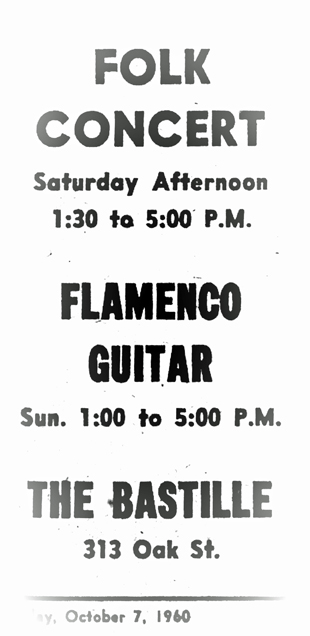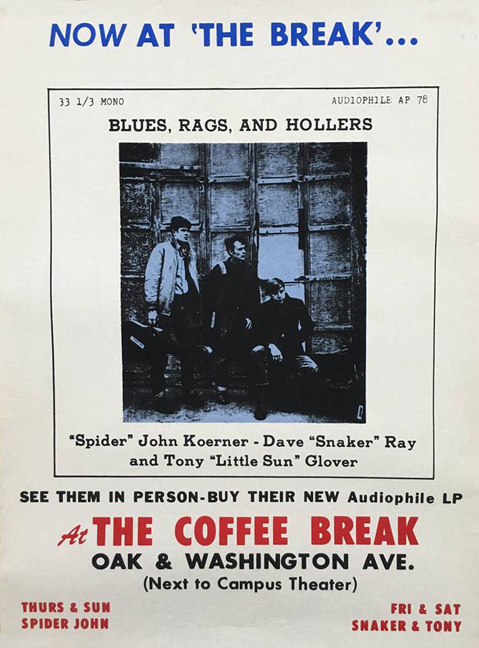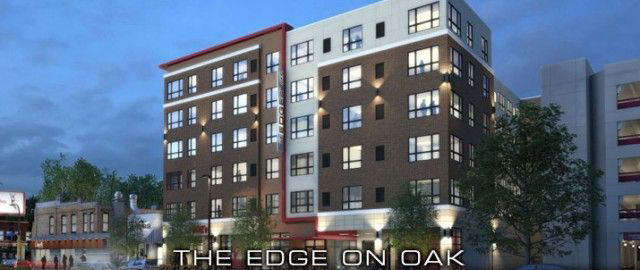Bastille
313 Oak Street SE
Minneapolis
This site at 313 Oak Street SE near Washington Avenue on the U of M Campus was the site of two cool coffee houses:
- The Bastille
- The Coffee Break
BUILDING HISTORY
The permit cards say that a house was moved onto this lot in 1905, with many alterations and additions after that. In 1908 it was described as a little cottage, the home of the beleaguered Andrew Stevens, whose wife died in childbirth, leaving him with eight children under the age of eleven.
In 1925, Miss Mai Marie Stevens tried out for the Daily Star Vanities, to be performed at the Seventh Street Theater. Andro and Anna Stevens continued to live here until Anna died in 1939. Andro remarried (it turned out Virginia was his third wife) and when he died in 1944 he left everything to Virginia, to the consternation of his four sons and three daughters. His will was determined to be valid by the court.
In 1930 the building was concurrently the home of Mr. and Mrs. B.A. Skinner. Bertha Skinner died in 1941.
THE BASTILLE
In 1960, Harvey Abrams and Bob Beull rented an old house near Oak and Washington Ave., rebuilt it, and named it the Bastille. Abrams, described by Robert Shelton as a “student radical and folk-song enthusiast,” told Shelton that Bob Dylan, then performing as Bob Dillon, played at the Bastille in the fall and early winter of 1960. (Robert Shelton, No Direction Home: The Life and Music of Bob Dylan, 2011)

COFFEE BREAK
The Coffeebreak, owned by Mel Leslie, opened in March 1961.
A January 1963 ad in the Select Twin Citian describes it as having a “‘Bohemian’” coffee house atmosphere on the first floor of a frame house next to the Campus Theater. “Dusty wooden floors, fish nets, stained glass windows. Authentic Negro blues performed by Dave Rey (sic). Friday and Saturday 9:30 to 1:30 am.”
Entertainment featured local blues artists such as Dave Ray and Tony Glover, and occasionally nationally-known performers like Rev. Gary Davis and Big Joe Williams. Performers received half of the $1 cover charge at the door.
“You could smell the hot cider when you walked in the door, recalled Leslie. It was very dark, with fishnets on the ceiling, a small platform and stained glass wind wind with lights behind them. The Break was a place to play chess, do book work, hang out, for coffee and swap songs and guitar work.”
Alan Slacter remembered:
The Coffee Break was my go-to, more approachable than the Scholar, and served hot apple cider in large stoneware mugs. Danny O’Keefe also played there and would accept requests, including one of my favorite folk songs, “Wanderin’.”
Leslie’s lease expired in 1965. He moved to 1900 Riverside Ave. on the West Bank, but funds were short and he and eventually sold his coffee house to the people who formed the New Riverside Cafe in 1970.

When 313 Oak Street SE was wrecked in July 1965, it had a footprint of 20′ by 50′ by 25′. It was a wood frame building with two stories.
A Red Barn fast food restaurant opened in November 1965. Mentions fall off on September 19, 1979.
Other restaurants replaced the Red Barn since.
THE EDGE
In 2011, an apartment complex called the Edge on Oak Street was built where beatniks used to roam. The property has been renumbered 401 Oak St. SE, and belongs to the University of Minnesota.



